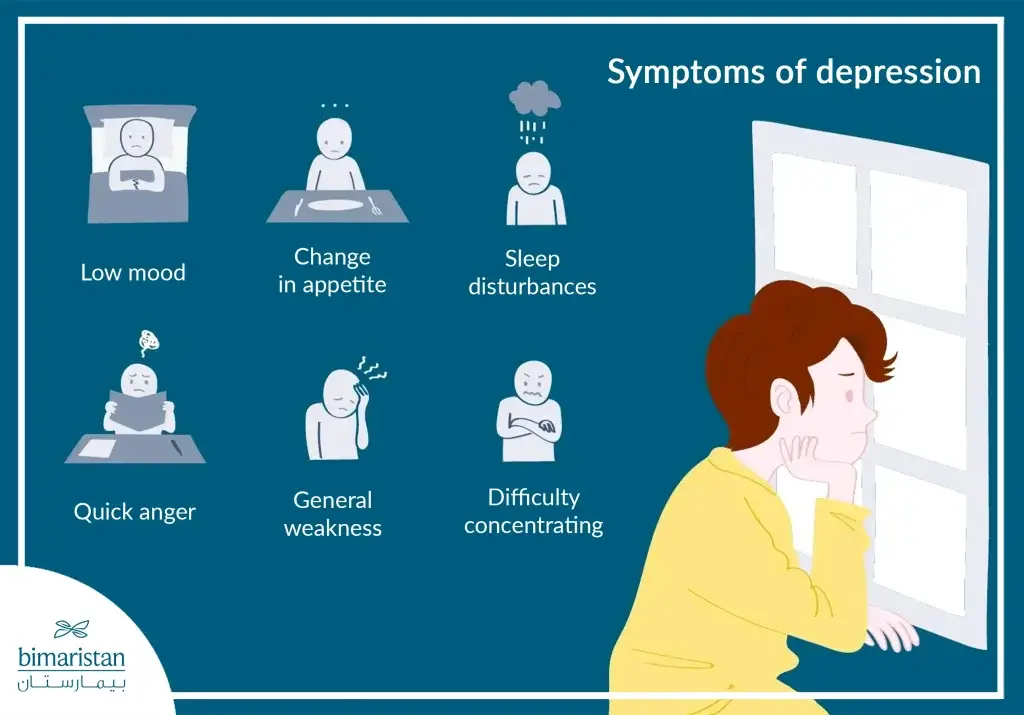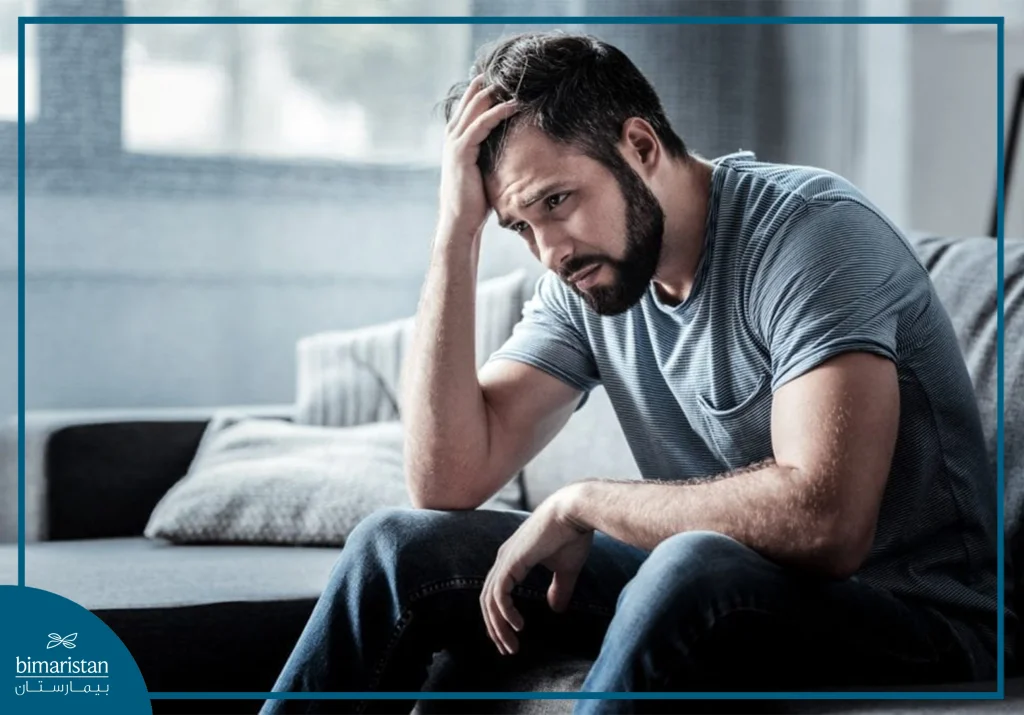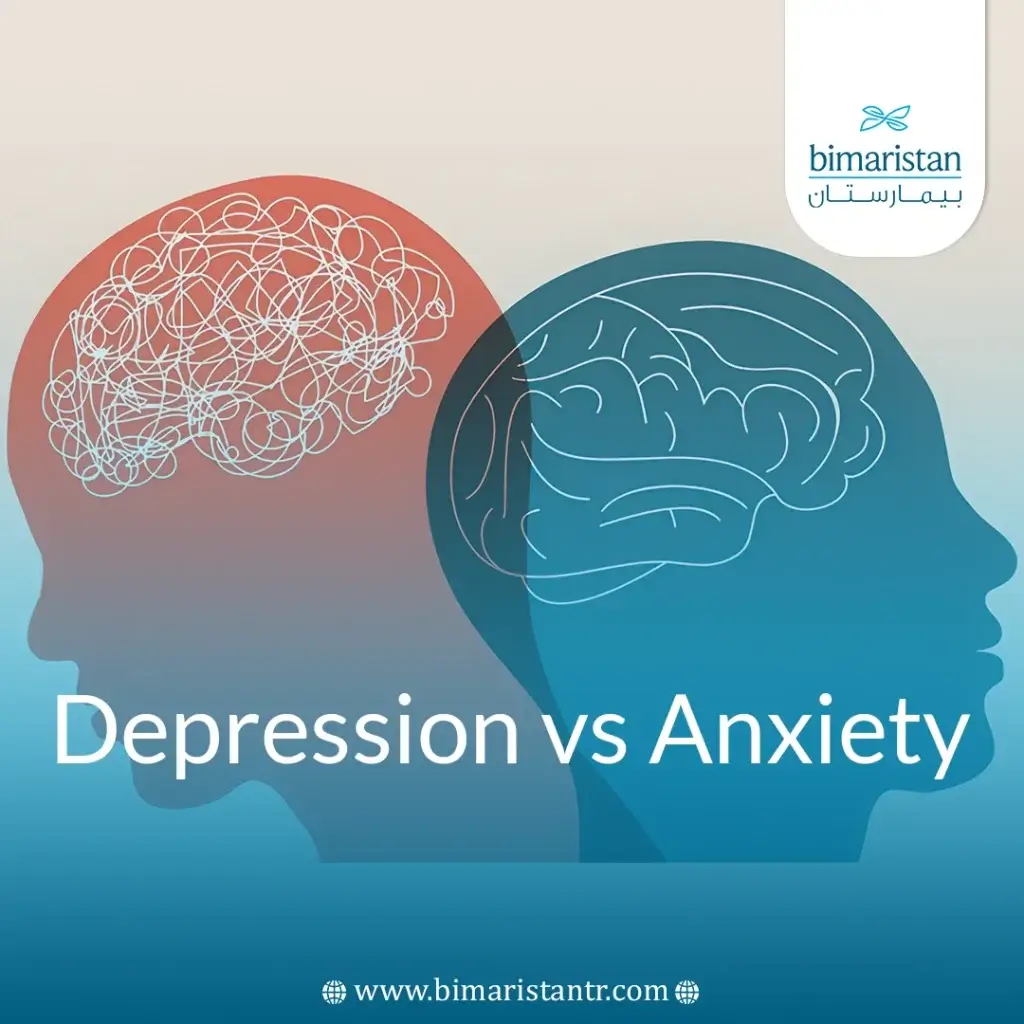Anxiety and depression are among the most common mental disorders today, significantly affecting mental and physical well-being. Although they share overlapping symptoms, the difference between depression and anxiety lies in the nature of the emotions and underlying causes.
This article aims to clarify the difference between depression and anxiety in terms of symptoms, causes, methods of diagnosis, and treatment approaches.
The difference between depression and anxiety
Depression
It is a mood and psychological disorder that causes a constant feeling of sadness and a loss of passion or interest in things, even those you once enjoyed.
It is a common health condition that affects patients’ daily lives and activities, and can affect and disrupt thinking, sleep, memory, and eating, so it is more than just a bout of bad mood.
Depression has different types depending on the symptoms and includes:
- Major depression (most common): This is a severe depression characterized by persistent sadness and loss of interest and pleasure in daily activities. It lasts about two weeks and interferes with daily activities.
- Chronic (persistent) depressive illness: Less severe than the previous pattern but lasts longer, up to two years.
- Bipolar depressive illness: Characterized by extreme mood swings ranging from deep sadness to mania.
- Seasonal (seasonal) depression: Occurs in a particular season of the year – usually fall and winter – and is caused by shorter days and less exposure to light.
- Perinatal depressive disorder: Pregnancy depression or postpartum depression may appear in some women and is characterized by sadness, anxiety, and fatigue.
- Depression with psychotic symptoms: Depression that is accompanied by auditory or visual hallucinations and delusions is sometimes called psychotic depression.
- Depressive disorder caused by another medical condition: Many medical conditions can cause changes in the body that lead to depression, such as hypothyroidism, heart disease, Parkinson’s disease, and cancer.
- Disruptive mood dysregulation disorder (DMDD): This disorder causes chronic severe irritability and frequent tantrums in children, usually beginning before the age of 10.
Anxiety
Anxiety is a type of mental health condition that causes fear and dread in response to certain things and situations, and is often accompanied by physical signs such as a rapid heartbeat and sweating.
People with anxiety disorders suffer from excessive and persistent fears and fear of everyday situations. Patients may experience repeated episodes of intense anxiety, fear, or sudden terror, where these episodes reach their peak within minutes and are known as panic attacks, which interfere with emotions and daily activities, are difficult to control, and can last for a long time.
Anxiety has different types depending on the symptoms, including:
- Generalized anxiety disorder: It involves persistent and excessive worry about activities, events, or even ordinary and routine issues, is difficult to control, and affects how you feel physically.
- Anxiety disorder due to a medical condition: Involves having symptoms of excessive anxiety or panic that are directly caused by a physical health issue.
- Separation anxiety disorder: A childhood disorder characterized by excessive developmental anxiety related to separation from parents.
- Social anxiety disorder (social phobia): Involves high levels of anxiety, fear, and avoidance of social situations due to fear of negative judgment from others.
- Specific phobias: Characterized by extreme anxiety when exposed to a specific object or situation, and may cause panic attacks in some people.
- Substance-induced anxiety disorder: Characterized by symptoms of severe anxiety or panic directly resulting from the misuse of drugs or medications, exposure to a toxic substance, or discontinuation of medications.
The difference between depression and anxiety in terms of symptoms
Symptoms of depression
- Psychological and mood symptoms
- Persistent feelings of sadness, anxiety, or hopelessness.
- Bouts of anger, irritability, or frustration, even over minor things.
- Constant thoughts of personal failure, self-blame, feelings of worthlessness, or guilt.
- Consistent negative thinking and focusing on past failures.
- Unexplained episodes of irritability or mood swings.
- Loss of interest or pleasure in daily and social activities, such as hobbies, relationships, or sports.
- Cognitive symptoms
- Difficulty thinking, concentrating, and making decisions.
- Poor memory and distraction.
- Slowness in thinking, speaking, or body movements.
- Behavioral symptoms
- Withdrawal from friends and family.
- Avoiding social activities that were once enjoyable.
- Tendency toward isolation, withdrawal, and loss of social contact.
- Physical Symptoms Polylang
- Persistent fatigue or feeling exhausted, even with simple tasks.
- Sleep disturbances: insomnia, excessive sleep, or difficulty waking up in the morning.
- Changes in appetite: loss of appetite or overeating.
- Unexplained weight changes (gain or loss).
- Unexplained physical problems, such as headaches, stomach pain, back pain, or sexual dysfunction.
- Serious and emergency symptoms
- Recurrent thoughts of death, suicide, or suicide attempts.
- Thoughts of self-harm or wishing you didn’t exist.

Symptoms of anxiety
- Psychological symptoms
- Feeling nervous, anxious, tense, or irritable.
- Feelings of impending danger, panic, pessimism, fear, or unease.
- Focusing on difficulties or thinking about anything other than the current anxiety.
- Difficulty controlling anxiety.
- Difficulty concentrating and having uncontrollable, intrusive thoughts.
- Physical Symptoms
- Increased heart rate.
- Increased breathing rate (hyperventilation) or shortness of breath.
- Feeling weak or tired.
- Difficulty sleeping or insomnia.
- Experiencing gastrointestinal (GI) problems.
- Muscle tension.
- Cold or sweaty hands.
- Dry mouth and nausea.
- Numbness or tingling in the hands or feet.
The difference between depression and anxiety in terms of causes and triggers
Anxiety and depression have many causes, and the following table shows the difference between depression and anxiety in terms of causes:
| Factors | Causes of anxiety disorders | Causes of depression |
|---|---|---|
| Brain chemistry and hormones | Several neurotransmitters and hormones play a role in anxiety, including norepinephrine, serotonin, dopamine, and GABA, and imbalances of these substances can contribute to anxiety. | Imbalances in neurotransmitters such as serotonin and dopamine or hormonal changes as a result of pregnancy can cause or trigger depression. |
| Genetic factors | Anxiety disorders tend to run in biological families, suggesting a possible role for genetics, especially if a parent or sibling is affected. | Depression is more common among people whose blood relatives have the condition. |
| Life stressors (environmental factors) | Extreme or long-term stress can alter the balance of neurotransmitters, and exposure to traumatic experiences can trigger the onset of anxiety disorders. | The loss of a loved one, trauma, divorce, isolation, or lack of support can trigger or trigger depression. |
| Medical causes (physical changes) | Physical or medical changes such as heart disease, diabetes, hyperthyroidism, asthma, and irritable bowel syndrome may lead to anxiety. | Chronic pain and chronic conditions such as diabetes can lead to depression. |
The difference between depression and anxiety in terms of diagnosis
How is depression diagnosed?
Depression is diagnosed in the following steps:
- A thorough understanding of symptoms and medical and psychiatric history: Healthcare providers diagnose depression through a thorough understanding of the patient’s symptoms and medical and psychiatric history.
- Identify the type of depression: The type of depression is determined by the symptoms, such as seasonal depression or postpartum depression.
- Symptom criteria: To diagnose depression, five depressive symptoms must occur almost daily throughout the day for at least two weeks.
- Physical examination: The doctor performs a physical examination and asks questions about health, because it may be that a certain health condition is the cause of the patient’s depression and can be cured by treating it.
- Lab tests: For example, your doctor may order a blood test called a complete blood count or test your thyroid to make sure it’s functioning properly.
- Psychological assessment: A mental health professional may ask questions about the patient’s symptoms, thoughts, feelings, and behavior patterns, as well as how these symptoms affect their daily life. The doctor will ask the patient to fill out a questionnaire to help answer these questions.
- DSM-5: A mental health professional may use the criteria for depression in the fifth edition of the Diagnostic and Statistical Manual of Mental Disorders (DSM-5), published by the American Psychiatric Association.
- Depression assessment tests: The doctor asks the patient to complete assessment tests such as the Becker Depression Inventory or the Hamilton Depression Inventory. These tests are used to assess the severity of symptoms and determine whether the patient is depressed or not.
- Establish a final diagnosis: Based on the information gathered from the interview and tests, the doctor diagnoses the disease and determines its severity (mild, moderate, severe).
How is anxiety diagnosed?
- A thorough understanding of symptoms and medical and psychological history: The doctor will start with a medical evaluation, which includes a physical examination, asking about medical history, medications used by the patient, and whether anyone in the family has an anxiety disorder.
- Psychological assessment: This includes a discussion of thoughts, feelings, and behavior to help determine a diagnosis and look for associated complications.
- A psychologist will conduct an interview or questionnaire to ask questions about symptoms, sleep habits, and other behaviors, and use DSM-5 criteria to diagnose anxiety disorders.
- There are no blood or imaging tests that can diagnose anxiety disorders, but your doctor may run some of these tests to rule out other organic conditions, such as hyperthyroidism.
The doctor must recognize and find the difference between depression and anxiety and assess the likelihood of the person having both conditions together, because almost 70% of people with depression also have an anxiety disorder. One condition can exacerbate the other, making treatment more complicated.

The difference between depression and anxiety in terms of treatment
Treatment of depression
- Psychotherapy: Psychotherapy is a general term for treating depression by talking about your condition and related issues (including cognitive behavioral therapy and relationship therapy).
- Behavioral therapy
- Life skills training: Helps develop strategies for coping with stress and difficulties.
- Relaxation and meditation techniques, Such as yoga or meditation, to promote relaxation and psychological well-being.
- Social Interventions
- Social support, such as joining support groups or talking with friends and family.
- Lifestyle improvements: such as exercising regularly and eating a healthy diet.
- Complementary and alternative therapies: Such as herbal therapy, art therapy, and music therapy.
- Brain stimulation: Used for people with severe depression or psychosis (includes electroshock, magnetic stimulation, and vagus nerve stimulation).
- Electroconvulsive therapy (ECT): Used in cases of severe depression or when other treatments have failed.
- Transcranial magnetic stimulation: This may be an option for people who do not respond to antidepressants.
- Inpatient and hospitalization: For some people, depression is chronic and requires hospitalization due to the need for intensive care.
- Pharmacotherapy
- Antidepressants: These are used to improve mood and reduce symptoms of depression. They include:
- Selective serotonin reuptake inhibitors (SSRIs), such as fluoxetine and sertraline.
- Serotonin and norepinephrine reuptake inhibitors (SNRIs), such as duloxetine and venlafaxine.
- Tricyclic antidepressants (TCAs), such as amitriptyline.
- Monoamine oxidase inhibitors (MAOIs), which are less commonly used due to their interactions with food.
- Hormone-balancing medications: These are used to treat depression associated with hormonal changes, such as postpartum depression, premenstrual mood swings, or menopause.
- Antidepressants: These are used to improve mood and reduce symptoms of depression. They include:
Anxiety treatment
- Psychotherapy
- Talk therapy: This involves talking or psychological counseling, working with a therapist to reduce anxiety symptoms and understand and manage the disorder.
- Cognitive behavioral therapy (CBT): One of the most effective forms of psychotherapy for anxiety disorders, it involves identifying thought patterns and behaviors that cause anxiety, then learning specific skills to improve symptoms and gradually return to activities the patient avoids due to anxiety.
- Medication
- Antidepressants: Although primarily used to treat depression, they can also help with anxiety disorders. The most commonly used types are serotonin reuptake inhibitors (SSRIs) and serotonin and norepinephrine reuptake inhibitors (SNRIs). Tricyclic antidepressants also exist, but they have more side effects.
- Benzodiazepines: These medications quickly reduce anxiety, panic, and tension, but they can lead to habituation and addiction. Examples include alprazolam, clonazepam, diazepam, and lorazepam.
- Beta blockers: Help reduce physical symptoms such as a racing heart and tremors, but they do not address the psychological aspects of anxiety.
When to consult a psychiatrist
A psychiatrist should be consulted in the following cases:
- Symptom overlap: When symptoms of depression and anxiety are mixed with other health issues.
- Signs of danger: Thinking about self-harm or suicide, or having a constant sense of hopelessness and loss of interest.
- Not responding to home remedies: Not improving after trying relaxation techniques, lifestyle changes, or social support.
- The impact of mental health on work and relationships: When symptoms significantly affect daily functioning, such as work, school, and social or family relationships.
In conclusion, although there are commonalities between the symptoms of depression and anxiety, the difference between depression and anxiety becomes clear when analyzing the feelings and behaviors associated with each. Early and accurate diagnosis is the most important step towards recovery and achieving psychological balance, as mental health is an integral part of quality of life.
Sources:
- Centers for Disease Control and Prevention. (n.d.). Depression and anxiety. CDC.
- Pomerleau, O. F., Zucker, A. N., & Stewart, A. J. (2003). Characterizing nicotine dependence in women and its relationship to mood and anxiety disorders. Journal of Substance Abuse Treatment, 24(3), 319-328
